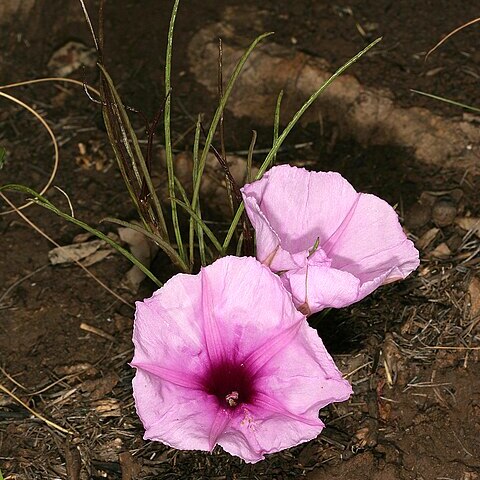Perennial herb; glabrous. Stems erect or procumbent. Leaves with blade either palmately 3-9-sect, with segments 20-70 x 0.5-3.0 mm, or simple, linear to bilobed, 40-150 x 2-7 mm. Flowers: peduncles 1-flowered; calyx lobes equal or unequal, narrowly ovate, 7-20 mm long, apices acute or acuminate, glabrous; corolla 40-75 mm long, bright magenta-pink, lighter outside, darker in centre and on midpetaline bands; Aug.-Apr. Fruit a subglobose-conical capsule, 10-12 mm in diameter; seeds with long, shiny, fawn-coloured hairs.
Leaf lamina palmately 3–9 sect, with very narrow, linear or filiform segments 20–70 × 0·5–4 (10) mm., sometimes somewhat pinnate to distinctly pinnate, if 3 terminal segments are partly fused to form a common rachis, or entire, linear, sometimes linear spathulate, 4–10 (15) × 0·2–0·4 (0·7) cm.; petioles of dissected leaves up to about 2 cm. long, of simple leaves sometimes inconspicuous because the leaf is much narrowed at the base.
A herb. The branches are trailing. They have leaves spaced along them. These have erect flowering shoots along them. The leaf blade is divided into 3 narrow lobes up to 6 cm long by 3 cm wide. The central lobe is the longest. The flowers are erect. They are funnel shaped and 4 cm long and 4 cm wide at the mouth. The are pink or purple. It has a fattened tuber about 15 cm wide.
Erect or prostrate perennial herb. Leaf lamina pal-mately 3-9-sect, with narrow linear or filiform segments or entire, linear, sometimes linear spathulate. Corolla 40-75 mm long. Seeds covered with long hairs. Flowers magenta-pink, mauve or rosy purple, darker in centre.
Flowers axillary; peduncle very short, rarely up to 6 cm. long; pedicels very short, thickened, rarely up to 15 mm. long; bracteoles, small, lanceolate, often deciduous.
Corolla funnel-shaped, magenta-pink, mauve or rosy-purple, darker in the centre, very rarely reported to be white, 4–7·5 cm. long and 4–6 cm. in diam.
Sepals ovate-lanceolate, lanceolate or oblong-lanceolate, sometimes ovate or elliptic, acute or acuminate, 8–16 mm. long, glabrous.
Perennial, glabrous from a thick tuberous, subglobose or somewhat fusiform root-stock, 5–13 mm. in diam.
Stems one or several, erect or prostrate, woody at the base, glabrous, terete, usually slender.
Capsule subglobose-conical, apiculate by the style-base, glabrous.
Seeds covered with long shiny fawn hairs.

